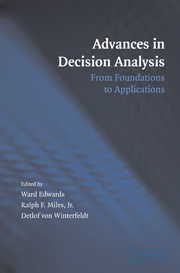Book contents
- Frontmatter
- Contents
- List of Contributors
- Preface
- 1 Introduction
- PART I HISTORY AND FOUNDATIONS OF DECISION ANALYSIS
- PART II STRUCTURING DECISION PROBLEMS
- PART III PROBABILITIES AND BAYES NETS
- 8 Eliciting Probabilities from Experts
- 9 Aggregating Probability Distributions
- 10 Model Building with Belief Networks and Influence Diagrams
- 11 A Bayesian Approach to Learning Causal Networks
- PART IV UTILITIES
- PART V RISK ANALYSIS
- PART VI DECISION ANALYSIS IN A BEHAVIORAL AND ORGANIZATIONAL CONTEXT
- PART VII APPLICATIONS OF DECISION ANALYSIS
- Index
- References
9 - Aggregating Probability Distributions
Published online by Cambridge University Press: 05 June 2012
- Frontmatter
- Contents
- List of Contributors
- Preface
- 1 Introduction
- PART I HISTORY AND FOUNDATIONS OF DECISION ANALYSIS
- PART II STRUCTURING DECISION PROBLEMS
- PART III PROBABILITIES AND BAYES NETS
- 8 Eliciting Probabilities from Experts
- 9 Aggregating Probability Distributions
- 10 Model Building with Belief Networks and Influence Diagrams
- 11 A Bayesian Approach to Learning Causal Networks
- PART IV UTILITIES
- PART V RISK ANALYSIS
- PART VI DECISION ANALYSIS IN A BEHAVIORAL AND ORGANIZATIONAL CONTEXT
- PART VII APPLICATIONS OF DECISION ANALYSIS
- Index
- References
Summary
ABSTRACT. This chapter is concerned with the aggregation of probability distributions in decision and risk analysis. Experts often provide valuable information regarding important uncertainties in decision and risk analyses because of the limited availability of hard data to use in those analyses. Multiple experts are often consulted in order to obtain as much information as possible, leading to the problem of how to combine or aggregate their information. Information may also be obtained from other sources such as forecasting techniques or scientific models. Because uncertainties are typically represented in terms of probability distributions, we consider expert and other information in terms of probability distributions. We discuss a variety of models that lead to specific combination methods. The output of these methods is a combined probability distribution, which can be viewed as representing a summary of the current state of information regarding the uncertainty of interest. After presenting the models and methods, we discuss empirical evidence on the performance of the methods. In the conclusion, we highlight important conceptual and practical issues to be considered when designing a combination process for use in practice.
Introduction
Expert judgments can provide useful information for forecasting, making decisions, and assessing risks. Such judgments have been used informally for many years. In recent years, the use of formal methods to combine expert judgments has become increasingly commonplace. Cooke (1991) reviews many of the developments over the years as attempts have been made to use expert judgments in various settings.
- Type
- Chapter
- Information
- Advances in Decision AnalysisFrom Foundations to Applications, pp. 154 - 176Publisher: Cambridge University PressPrint publication year: 2007
References
- 76
- Cited by



